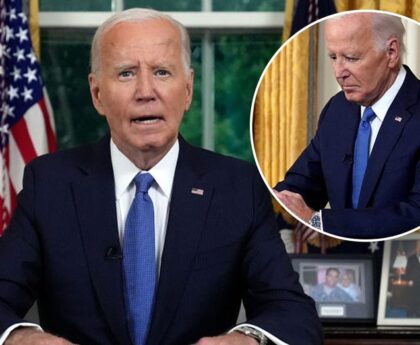The World Health Organization (WHO) has just published its first report on the global impact of hypertension and how people can win the race against this “silent killer” that often presents without symptoms.
“This important report from WHO shows how high blood pressure is common and growing in prevalence, but is under-detected and under-treated globally,” Dr. Deepak L. Bhatt, director of Mount Sinai Heart at the Icahn School of Medicine in New York City, told Fox News Digital.
“This is despite the existence of known lifestyle measures (such as dietary salt reduction and weight loss) and generic medicines that are effective in controlling blood pressure in the majority of patients if implemented appropriately — which is what health care systems around the world need to do now,” he added in an email.
DOCTOR SHARES 3 SMART TIPS FOR STAYING HEALTH IN THE MONTHS AHEAD: AND THEY MAY SURPRISE YOU
High blood pressure affects one in three adults globally.
It has serious health consequences if it’s left untreated. Those consequences include stroke, heart attack, heart failure and kidney issues, according to the report.
Dr. Marc Siegel, a professor of medicine at NYU Langone Medical Center and a Fox News medical contributor, commented to Fox News Digital on the issue, “High blood pressure is simple and important to understand.”
He said, “The heart is a pump — and it is pumping against resistance. The greater the resistance from the arteries, the more pressure on the heart and the more likely it could fail, or be damaged by insufficient blood flow or develop an abnormal rhythm and throw off a clot (stroke) or increase pressure on the kidneys, which causes them to fail.”
He noted, “High blood pressure affects multiple organs, damaging them.”
The arteries carry blood from the heart to other parts of the body, according to the Centers for Disease Control and Prevention (CDC).
Blood pressure is the pumping of the blood against the wall of arteries, according to the CDC.
In 2017, the American College of Cardiology and the American Heart Association lowered the threshold of what defines high blood pressure to at or above 130/80 mmHg, which is known as Stage 1 hypertension.
Approximately 120 million Americans — or 48% of adults in the U.S. — either have Stage 1 hypertension or are taking medication for hypertension, but only 1 in 4 adults have their blood pressure under control, according to the CDC.
Stage 2 hypertension is defined as 140/90 mmHg or higher.
The WHO notes that the number of people living with a blood pressure of 140/90 or higher or taking a medication to treat the condition doubled from 1990 to 2019 from 650 million to 1.3 billion.
Approximately half of people worldwide are living with hypertension without being aware of the chronic medical condition.
WANT A MORE ACCURATE BLOOD PRESSURE READING? TRY LYING DOWN WHEN IT’S TAKEN, NEW STUDY SUGGESTS
The vast majority — 75% — of people living with hypertension reside in low- and middle-income countries.
“Hypertension can be controlled effectively with simple, low-cost medication regimens, and yet only about one in five people with hypertension have controlled it,” WHO Director-General Dr. Tedros Adhanom Ghebreyesus, noted in a news release.
If more people are appropriately treated for high blood pressure that mirrors levels of high-performing countries, this may prevent 76 million deaths, 120 million strokes, 79 million heart attacks and 17 million cases of heart failure between now and 2050, the WHO predicted in its release.
High-performing countries, such as Canada and South Korea, initiated national treatment programs resulting in more than 50% adults living in those areas with blood pressure that is now under control.
But effective blood pressure management can occur in countries of all income levels.
Over 40 low- and middle-income countries, such as Cuba, Bangladesh, India and Sir Lanka, have enrolled over 17 million people into treatment programs.
The American Heart Association (AHA) recommends that you “know your numbers” if you think your blood pressure is in an unhealthy range.
BE WELL: ADD AN EGG (OR 3) TO YOUR DAILY DIET FOR HEART HEALTH
They recommend checking blood pressure regularly after a diagnosis of hypertension and to trend blood pressure measurements over time.
The association reminds people to practice heart-healthy eating, which includes a diet rich in fruits and vegetables, and watching sodium intake.
AHA recommends a daily sodium intake of no more than 2,300 milligrams (mg) a day but ideally no more than 1,500 mg per day for those with high blood pressure.
The CDC notes the average American has more than 3,400 mg of sodium every day, but one simple lifestyle change is to skip the table salt.
In 2013, all 194 countries who are members of the WHO committed to reducing sodium intake by 30% by 2025, but only 5% have implemented comprehensive strategies so far, according to a recent report.
5 GREAT WAYS THAT MORNING EXERCISE CAN SET YOU UP FOR A BETTER WORKDAY
The association also recommends people look for the “Heart-Check mark” on certain food packaging that meets AHA criteria for saturated fat, trans fat and sodium for a single serving of the food product for healthy people over age 2.
Getting exercise is also important to control one’s blood pressure
This equates to at least 150 minutes each week of moderate-intensity physical activity, such as brisk walking in most healthy people.
The weekly physical activity can be spread out throughout the week, with an easy plan to remember perhaps 30 minutes a day for at least five days a week.
CLICK HERE TO SIGN UP FOR OUR HEALTH NEWSLETTER
People should also participate in muscle-strengthening activity at least two days each week.
More than 1,000 people die from strokes and heart attacks every hour — yet most of these deaths are preventable by controlling blood pressure, according to Dr. Tom Frieden, president and CEO of the organization Resolve to Save Lives.
Melissa Rudy of Fox News Digital contributed reporting.
For more Health articles, visit www.foxnews.com/health.
Article Source: Health From Fox News Read More




